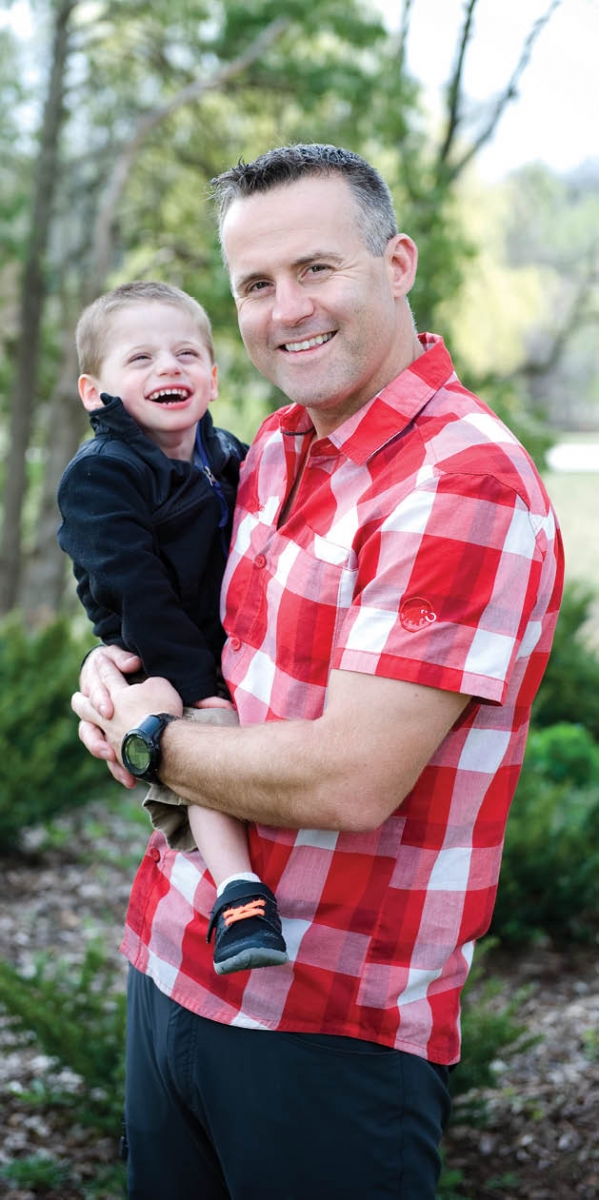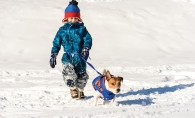In early January, as Minnetonka resident Kyle Rooney struggled to reach the 19,341-foot-high summit of Mount Kilimanjaro, he thought about his son’s daily struggles with a rare disease, and felt a heightened sense of purpose.
Along with three friends, Rooney (who works as a division manager for an ophthalmic surgery company) made the trek up Tanzania’s Mount Kilimanjaro to raise awareness and funds for the Angelman Syndrome Foundation in honor of his son, Madden, who has Angelman syndrome. Madden will turn 3 years old next month. His twin brother, Declan, does not have the disorder, nor does their 1-year-old brother Conrad.
Angelman syndrome is a genetic disorder that causes developmental disabilities and neurological problems like difficulty speaking, balancing and walking, and, in some cases, seizures. There is no cure for the disorder.
About six months after their twins were born, Kyle Rooney and his wife, Shawna, began noticing differences in their boys. Madden was having difficulties visually tracking objects, while Declan seemed more on track with developmental milestones for his age. The Rooneys took Madden to their pediatrician and an ophthalmologist, who recommended that they visit a geneticist. While researching symptoms online, Kyle found information about Angelman syndrome that seemed to match his son’s condition. After several months of testing, the geneticist confirmed the diagnosis.
To help Madden deal with his physical challenges, he participates in physical, occupational and speech therapy several times a week at home, at St. David’s Center, and at Gillette Children’s clinic in Minnetonka. The relatively early intervention in Madden’s case gives his parents hope for what he might yet accomplish. For example, Madden’s balance has shown improvement, and he is working toward being able to walk. If he achieves that skill, the Rooneys are hoping that “a new level of development will manifest itself in other ways,” says Kyle, hopefully including speech, feeding himself, and more.
One day, while watching a segment about mountain climbing on TV, Kyle Rooney came up with the idea of summiting Mount Kilimanjaro for his son. Though Rooney is an experienced athlete, he had never done much climbing. He realized that his venture would spark conversations that would lead to talking about his son’s experiences with the disorder, thus providing opportunities to educate people about Angelman syndrome—and providing a natural way to bring up the topic. “It’s worked like a charm; it’s created a safe environment for people to discuss it. I’ve gotten comfortable and good at explaining what it is to so many friends and family members who didn’t know about Angelman’s,” he says.
After hatching the idea, Rooney had to find others who’d be willing to make the climb with him. Rooney had no prior climbing experience, but fortunately an acquaintance, Gary Wrothy, did. Rooney called Wrothy, who quickly agreed to participate. They recruited two other friends to make the climb: JW Wilson and Pete England. (Rooney is the only one of the group who lives in Minnesota).
During his campaign leading up to the climb, Rooney set up a website and reached out to other Angelman’s families, and invited them to send a photo and brief story about their experience with the disease. “The pictures and stories started flooding in, and I decided to take them all with me,” he says. Rooney’s backpack for the trek carried 20 pounds of laminated photos from 70 families; he also carried and planted a flag made by the Angelman Syndrome Foundation.
Rooney, 39, began the trek in pretty good shape. He’s a distance runner who’s completed three marathons, and he played two years of college football at the University of Iowa. Kilimanjaro is the highest freestanding peak in the world, and Rooney chose it for his first climb because it is not considered a “technical climb”: no ropes, ice axes or similar equipment is required. But summiting Kilimanjaro is still a formidable athletic feat. Rooney and his friends experienced extreme discomfort due to the altitude, and slept in tents in near-zero-degree nighttime temperatures for the better part of a week.



(Left and middle photos courtesy of Kyle Rooney; Photo on far right by Emily J. Davis)
Accompanied by two experienced Tanzanian guides, the group spent five days ascending the mountain, without using supplemental oxygen (although it was available in case of emergency). The trip up took five days, and the descent required about a day and a half. The climbers would hike from 7 a.m. to 5 or 6 p.m. each day with a couple of breaks. On summit day, they hiked the final stretch from 1 to 7 a.m.
Temperatures were extreme. The trip up began in 90-degree heat, and by the time the group reached the mountaintop, it was 10 degrees below zero, with dangerous wind chills, Rooney recalls. For him, the most challenging point of the trek actually happened after the summit, when the group ran out of food and water, and Rooney experienced “pretty bad” oxygen sickness, including headaches and nausea on the way down. During the climb, guides used cell phones (when a signal was available) to send updates to the base camp, and email updates were then sent to Shawna and his family back in Minnetonka. Shawna updated the group’s Facebook page as the week went on. “To hear their health checks went well every day was a huge relief,” says Shawna. “The way Kyle is wired, he knows no human limitations. So he would continue on, even if he was struggling with the altitude.”
What Rooney had anticipated would be a “family and friends” fundraising effort quickly turned into much more. “People all over the world heard our story and followed us online,” he says. As of this writing, Rooney’s website has collected around $10,000 in donations for the Angelman Syndrome Foundation, and donations are still coming in via email and Facebook. In addition to North America, donations and photos have come from as far away as Mexico, Greece, China, Australia and Africa.
But Rooney isn’t finished with his mission to raise funds for and awareness of Angelman’s. In fact, he’s not even done with climbing. He’s planning a one-day, 26-mile hike up Pike’s Peak in Colorado next month. This fall, he plans to make his first technical climb, which will require more specialized equipment and training, to the summit of Mount Rainier in Washington state.
In retrospect, Rooney says the Kilimanjaro climb was “so much harder than I anticipated. But it was an amazing experience, and it was unbelievable how well it paralleled” the physical and mental challenges of Angelman’s. “It was a tribute to what Madden does and the challenges he faces. As Madden’s parents, we try to empathize with what he goes through, but we still don’t really feel those challenges the way he does. But this was a way to do that,” Rooney explains.
Eileen Braun, executive director of the Illinois-based Angelman Syndrome Foundation, was effusive in her praise of Rooney’s efforts. “Kyle is truly exceptional. We are in awe of him and we are incredibly honored to have his energy and support behind the Angelman Syndrome Foundation and Angelman community.”










